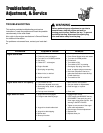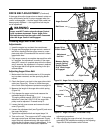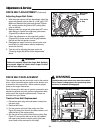
29
Specifications
ENGINE:
7.5 HP* Briggs & Stratton OHV
Make Briggs & Stratton
Model Intek Snow
Horsepower 7.5 HP @ 3600 rpm
Displacement 12.6 Cu. in (206 cc)
Oil Capacity 20 oz. (,59 L)
7.5 HP* Briggs & Stratton OHV (Euro)
Make Briggs & Stratton
Model Intek Snow
Horsepower 7.5 HP @ 3600 rpm
Displacement 12.6 Cu. in (206 cc)
Oil Capacity 20 oz. (,59 L)
CHASSIS:
Wheels Inflation Pressure: 20 psi (1,37 bar)
Spout Rotation 190 Degrees
Impeller 10” (25.4 cm) 4 Blade Ribbon Flighted Steel
Drive System Friction Disc, 5 Forward Speeds, 2 Reverse
DIMENSIONS
Effective Clearing Width
-I75246E, EI75246E, 24” (65 cm)
I7524E, I7524EX,
EI75246
Length
-I75246E, EI75246E, 51” (132 cm)
I7524E, I7524EX,
EI75246
Height
-I75246E, EI75246E, 43” (109cm)
I7524E, I7524EX,
EI75246
Weight
-I75246E, EI75246E, 158 lbs. (72 kg)
I7524E, I7524EX,
EI75246
NOTE: Specifications are correct at time of printing and are subject to change without notice.
* Actual sustained equipment horsepower will likely be lower due to operating limitations and environmental factors.
CE COMPLIANCE SPECIFICATIONS
Model
RPM’s
(Governed)
Kilowatts (kW)
(@ Governed
RPM’s)
Unit Mass (kg)
Sound Power
(LWA) (dBA)
Sound Pressure
(LPA) (dBA)
Vibration at
Handle (m/s
2
)
EI75246E 3600 5.6 72 105 90 8.5
I7524EX 3600 5.6 72 105 90 8.5
EI75246 3600 5.6 72 105 90 8.5
Technical Information
Power Ratings
The power ratings for an individual engine model are initially developed by starting with SAE (Society of Automotive
Engineers) code J1940 (Small Engine Power & Torque Rating Procedure) (Revision 2002–05). Given both the wide
array of products on which our engines are placed, and the variety of environmental issues applicable to operating
the equipment, it may be that the engine you have purchased will not develop the rated horsepower when used in a
piece of power equipment (actual “on–site” power). This difference is due to a variety of factors including, but not lim-
ited to, the following: differences in altitude, temperature, barometric pressure, humidity, fuel, engine lubrication, max-
imum governed engine speed, individual engine to engine variability, design of the particular piece of power equip-
ment, the manner in which the engine is operated, engine run–in to reduce friction and clean out of combustion
chambers, adjustments to the valves and carburetor, and other factors. The power ratings may also be adjusted
based on comparisons to other similar engines utilized in similar applications, and will therefore not necessarily match
the values derived using the foregoing codes.


















